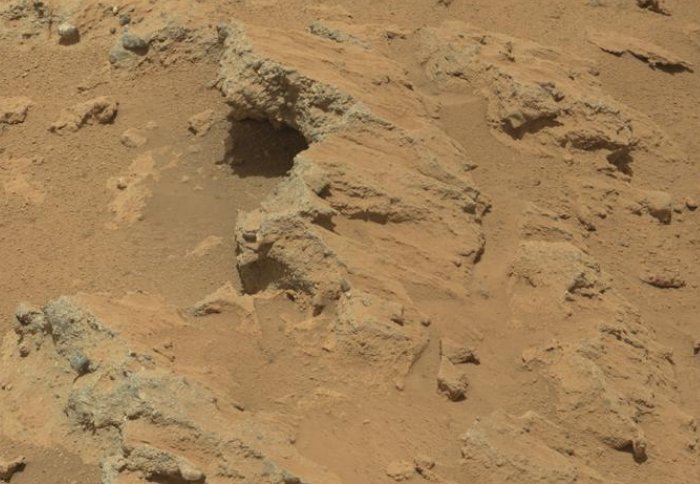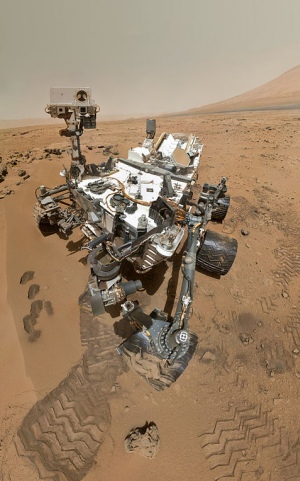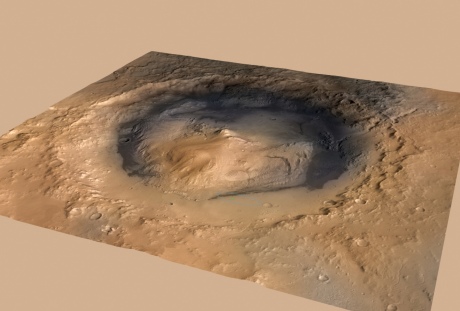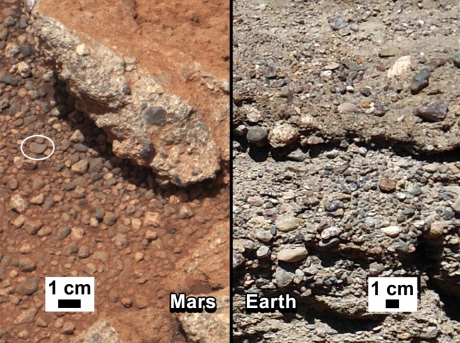Are you curious about Mars…?

Remnants of an ancient streambed on Mars. Credit: NASA/JPL-Caltech/MSSS
One year on, what has Curiosity told us about the mysterious Red Planet?
Curious about Mars? So are NASA and the Department of Earth Science and Engineering at Imperial College London. For decades, NASA has sent some pretty amazing instruments to the Red Planet to be our eyes, ears and hands, in an attempt to better understand this intriguing planet.
Curiosity is NASA’s latest Martian adventurer. The rover left Earth in November 2011, making the journey to Mars in about 8 months. Launching a new mission takes years of preparation and has to be timed to perfection. You can’t send a rover at any time you see. To successfully make the journey from Earth to Mars, a rover has to be sent when the planetary alighnment of Mars and Earth is suitable, and engineers and scientists have only a relatively short time window to ensure it successfully makes the journey to its target.
But launched it was and get there it did. A few weeks ago, on 6 August 2013, Curiosity celebrated its one-year anniversary on the surface of the Red Planet.
Curiosity’s mission is this one: to find out if Mars ever had the right environment to support microbial life.

Self-portrait of Curiosity in Gale Crater.
We know from previous missions on the ground and from satellite images of Mars that the planet once had liquid water at its surface. The twin rovers Spirit and Opportunity, who landed on Mars in 2004, sent home some striking images of Martian features and minerals showing evidence of past liquid water. Satellites have also captured photographs of huge geological structures looking very much like floodplains found on the surface of the Earth.
But Curiosity wants to know more than that. Was this water flowing? What does it tell us about how habitable Mars’ environment was in the past? Was it the right kind of water to support life? These questions are important for one particular reason: On Earth, life likely started under water, under a very particular set of environmental conditions. What we want to know now is whether such conditions also existed on Mars. If so, it will tell us that Mars may have once been habitable and favourable for the development of life forms. That is not to say that we will know whether life definitely evolved there, but it will give us a very strong idea of where to start looking for it if it did.
To do this, Curiosity needs to be able not just to take photographs, but also to collect samples and analyse them. What the NASA engineers designed is as close as we could be to sending scientist on Mars. Curiosity can drill samples, collect powders from Mars’ surface and analyse them directly in its personal laboratory to determine their mineralogy and chemistry, just as scientists do here on Earth. The rover has 10 state-of-the art instruments capable of measuring a whole range of Martian characteristics: from temperature and pressure to background radiation and chemical compositions.
Curiosity landed in Gale crater. This landing site was selected because scientists think that the rocks there could reveal a lot about the planet’s past. Rising from the centre of the crater is Mount Sharp (officially Aeolis Mons), a 3 mile-high mountain containing the thickest succession of sediments yet observed on Mars. The base of the mountain is Curiosity’s ultimate destination. Scientists hope that the sediments there will help unravel a long history of environmental conditions and sedimentary deposition.

Gale crater with Mount Sharp at its centre.
Since its arrival, Curiosity has been very busy. It has discovered yet more direct evidence of liquid water: sedimentary structures and rocks, which look identical to those we find on Earth in rivers and streams. The rover also collected its first set of samples in an area called Yellowknife bay. These drill holes immediately revealed some new information: the soils under the red surface were grey. This, NASA scientists say, shows that the iron in the soil is reduced, a form that is important for microbial activity. More analyses revealed the presence in these rocks of further chemical ingredients necessary for life.
Professor Sanjeev Gupta, lecturer in the department of Earth Science and Engineering, is one of the Curiosity science team members working on the Curiosity mission. He travelled to NASA for the rover’s landing last summer and has been directly involved with the scientific decisions ever since: Where does the rover go from here? What should it look at? Where should it drill? His work continues from London and Prof Gupta is one of the people who receive scientific and geologic information directly from the rover.
Within the first few weeks it spent on Mars, Curiosity imaged some rocks geologists call conglomerates. But, as a geologist myself, I can imagine that my first instinctive reaction upon seeing these rocks might have been one of disappointment. A conglomerate? That’s pretty boring... plenty of those on Earth looking exactly the same… Where are all the new and exotic rocks they were hoping to see?

An outcrop on Mars showing the characteristics of an Earth conglomerate.
But that is exactly why these rocks are so special. Prof Gupta explains that they look exactly the same as those we find on Earth in riverbeds. Conglomerates are rocks made of little round pebbles encrusted in a finer sandy or muddy component called the matrix. The pebbles are really what tell us a lot about the past environment. The key to pebbles in a river conglomerate on Earth is that they are round. These round edges are the result of the pebbles being transported by water flowing in the river. As the water moves the rocks around, they collide with one another, slowly chipping off their sharp edges with each collision and eventually becoming smooth and round. When the current finally slows down or the environment changes, the pebbles settle into the sediment at the base of the river and over time become one such conglomerate.
So the Martian conglomerates don’t just indicate that there was water. They show that the water was flowing quite vigorously, and for long enough that the pebbles became perfectly smooth. The chemicals measured by Curiosity in the Martian rocks further indicate that this water would have been freshwater, neither too salty nor too acidic, just right for life to thrive in.
Have scientists found life on Mars? Not yet. But they have found solid evidence that the environment there used to be a hospitable one, very similar to that where life started here on Earth. And that is what NASA sent Curiosity to find out: clues that Mars did indeed once support the right environment for life to emerge. So Curiosity has already fulfilled its mission.
But there is much more to come yet. The rover is slowly making its way to the base of Mt Sharp. Along the way, it will continue to see, sense and sample all parts of the Martian environment, and to send NASA scientists, Prof Gupta and the world some incredible new pieces of scientific data that will help researchers slowly piece together the puzzle of our red neighbour.
Article text (excluding photos or graphics) © Imperial College London.
Photos and graphics subject to third party copyright used with permission or © Imperial College London.
Reporter
Marion Ferrat
Centre for Environmental Policy